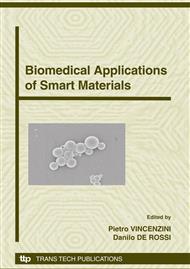p.204
p.210
p.216
p.220
p.226
p.235
p.241
p.247
p.257
Design of a Progressively Expandable Stent Using Finite Elements
Abstract:
Currently, a minimally invasive surgery called stenting is extensively used to increase the lumen of partially obstructed arteries. Unfortunately, restenosis, a postoperative phenomenon in which the lumen of the artery is reduced due to a traumatism of the artery, is still a concern. The most popular solution that has been adopted by stent manufacturers comprises drug-eluting stents. This paper presents a new stent concept in which the treatment of restenosis is carried out from a completely different angle. Indeed, instead of traumatizing the artery, and then trying to control restenosis with drugs, the new stent minimizes the traumatism of the artery by expanding itself, not instantaneously, but progressively, and in a controlled manner. To achieve this, a nitinol stent over which a series of polymer rings are installed tries to reach a fully deployed configuration, but the polymer rings, which act as a retainer, become soft over time due to creeping. Thus, after the initial deployment in the artery, the stent continues its expansion autonomously over an extended period of time (a few weeks). It is believed that the artery has enough time to adapt to the expansion, leading to minimum traumatism. This paper presents the stent design.
Info:
Periodical:
Pages:
241-246
Citation:
Online since:
September 2008
Keywords:
Price:
Сopyright:
© 2008 Trans Tech Publications Ltd. All Rights Reserved
Share:
Citation:


